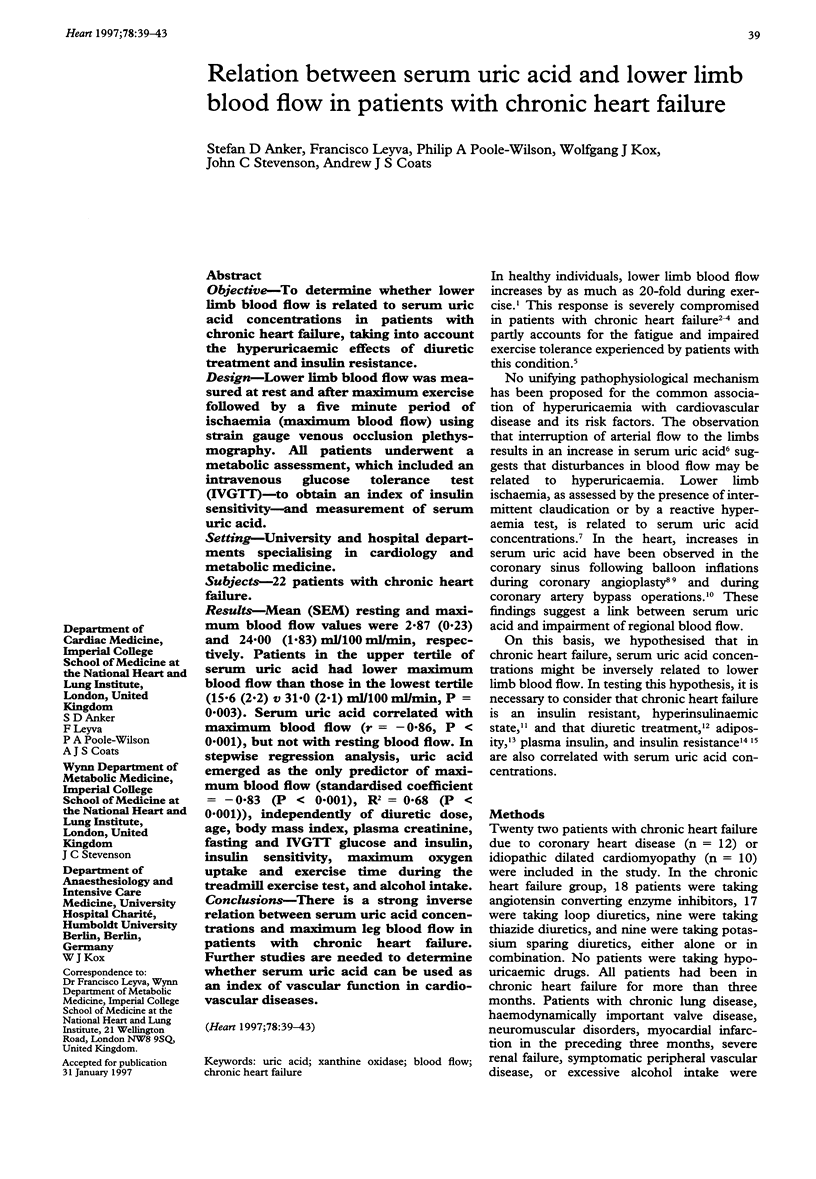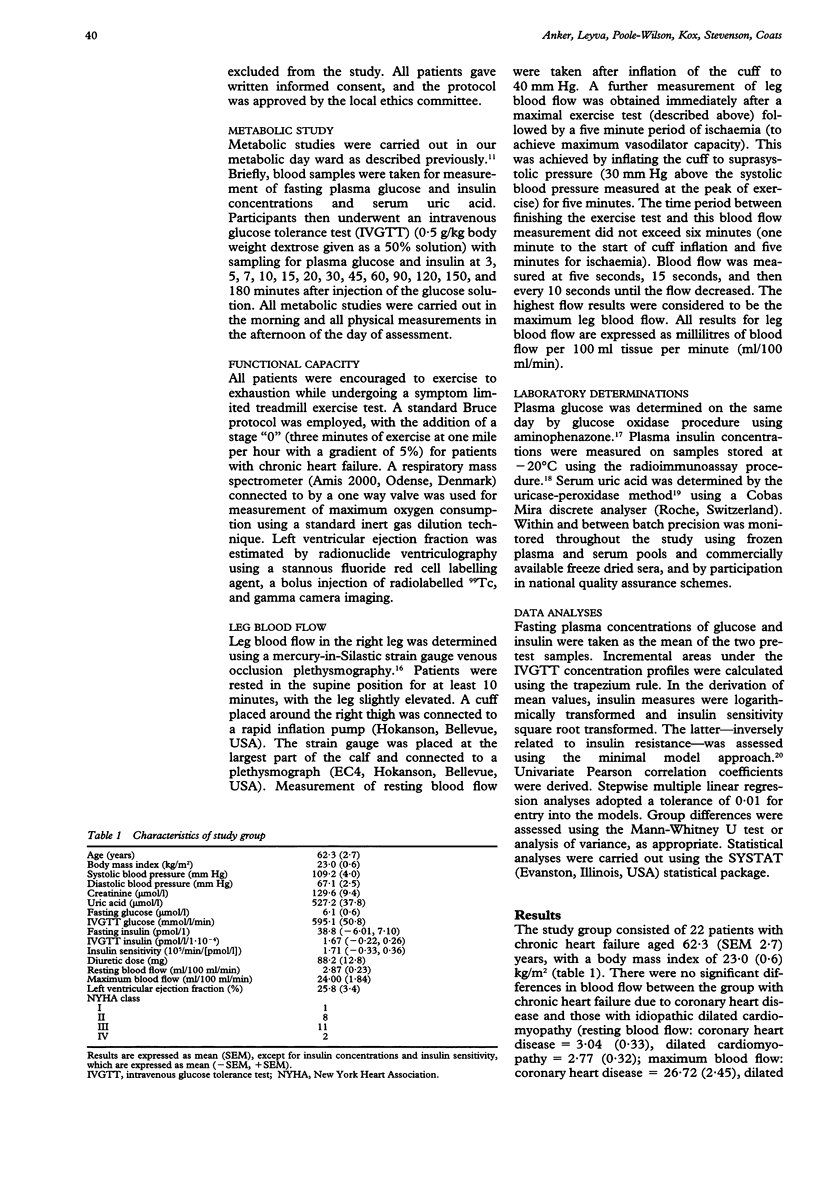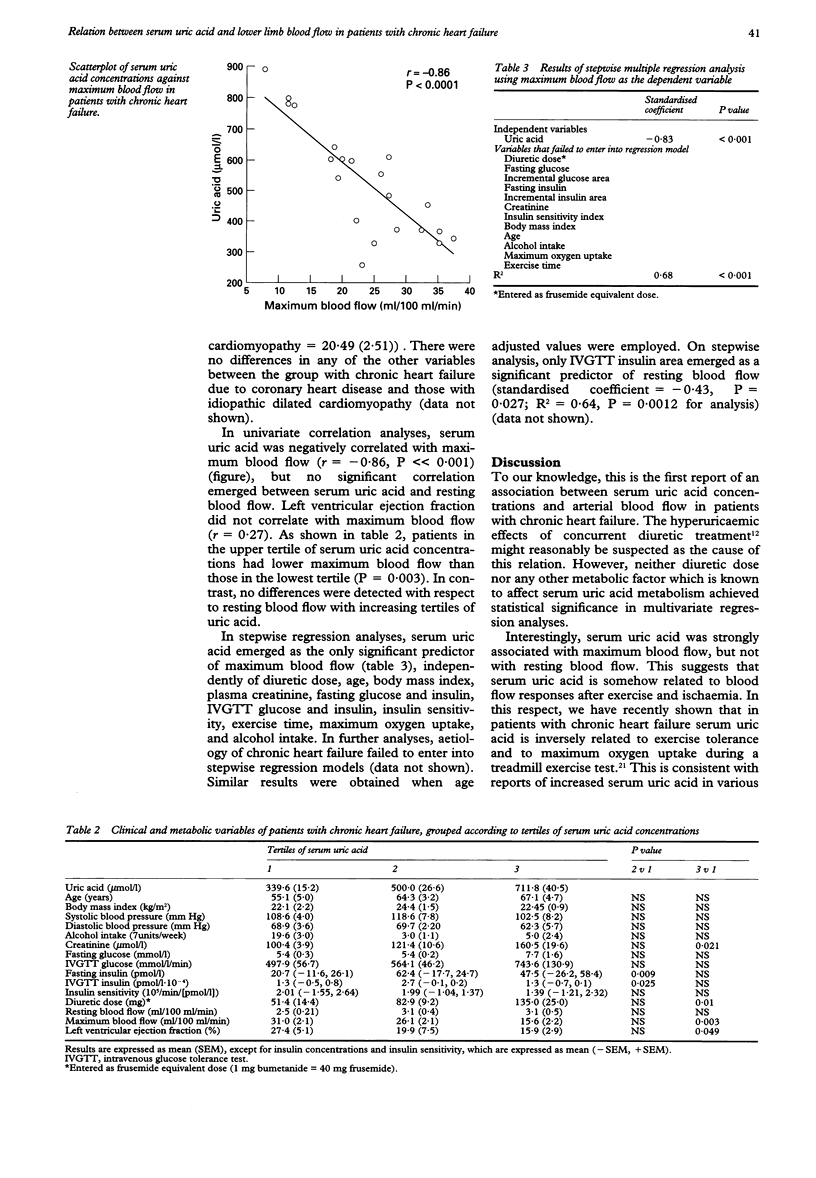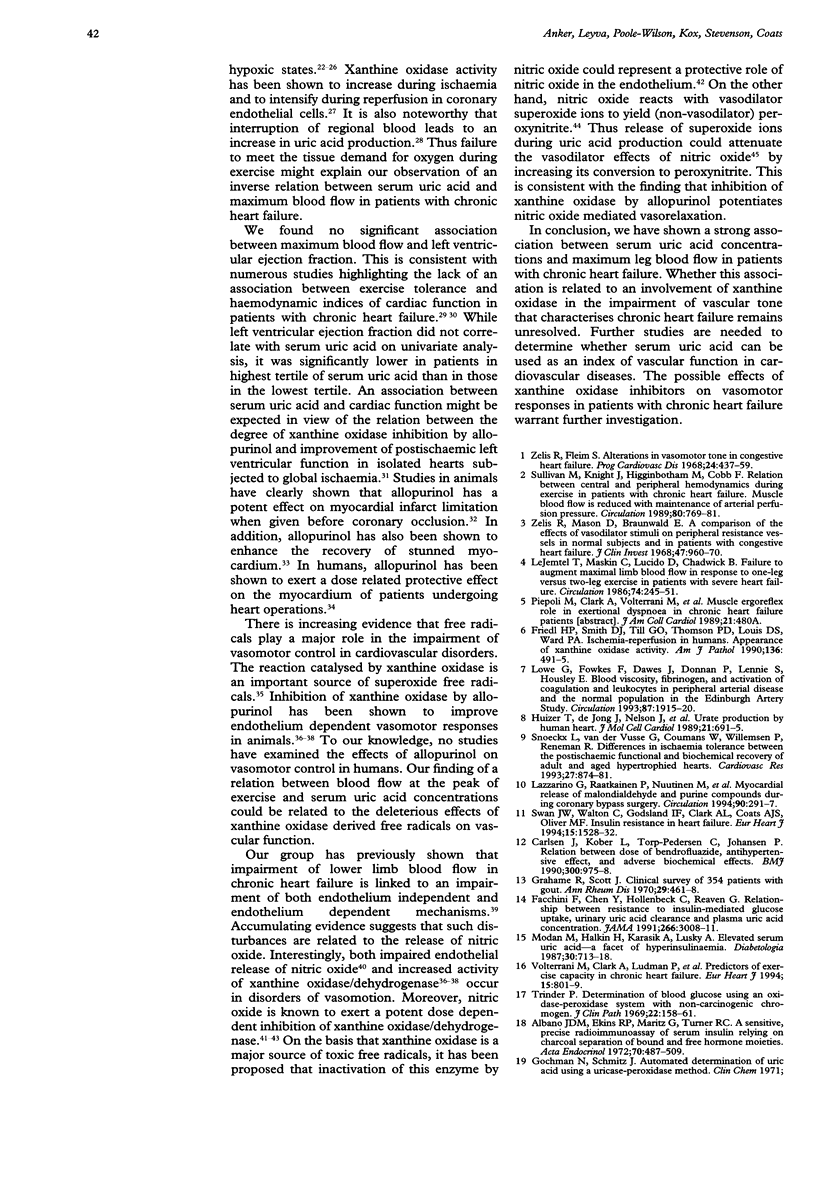Abstract
OBJECTIVE: To determine whether lower limb blood flow is related to serum uric acid concentrations in patients with chronic heart failure, taking into account the hyperuricaemic effects of diuretic treatment and insulin resistance. DESIGN: Lower limb blood flow was measured at rest and after maximum exercise followed by a five minute period of ischaemia (maximum blood flow) using strain gauge venous occlusion plethysmography. All patients underwent a metabolic assessment, which included an intravenous glucose tolerance test (IVGTT)-to obtain an index of insulin sensitivity- and measurement of serum uric acid. SETTING: University and hospital departments specialising in cardiology and metabolic medicine. SUBJECTS: 22 patients with chronic heart failure. RESULTS: Mean (SEM) resting and maximum blood flow values were 2.87 (0.23) and 24.00 (1.83) ml/100 ml/min, respectively. Patients in the upper tertile of serum uric acid had lower maximum blood flow than those in the lowest tertile (15.6 (2.2) v 31.0 (2.1) ml/100 ml/min, P = 0.003). Serum uric acid correlated with maximum blood flow (r = -0.86, P < 0.001), but not with resting blood flow. In stepwise regression analysis, uric acid emerged as the only predictor of maximum blood flow (standardised coefficient = -0.83 (P < 0.001), R2 = 0.68 (P < 0.001)), independently of diuretic dose, age, body mass index, plasma creatinine, fasting and IVGTT glucose and insulin, insulin sensitivity, maximum oxygen uptake and exercise time during the treadmill exercise test, and alcohol intake. CONCLUSIONS: There is a strong inverse relation between serum uric acid concentrations and maximum leg blood flow in patients with chronic heart failure. Further studies are needed to determine whether serum uric acid can be used as an index of vascular function in cardiovascular diseases.
Full text
PDF




Selected References
These references are in PubMed. This may not be the complete list of references from this article.
- Albano J. D., Ekins R. P., Maritz G., Turner R. C. A sensitive, precise radioimmunoassay of serum insulin relying on charcoal separation of bound and free hormone moieties. Acta Endocrinol (Copenh) 1972 Jul;70(3):487–509. doi: 10.1530/acta.0.0700487. [DOI] [PubMed] [Google Scholar]
- Bergman R. N., Ider Y. Z., Bowden C. R., Cobelli C. Quantitative estimation of insulin sensitivity. Am J Physiol. 1979 Jun;236(6):E667–E677. doi: 10.1152/ajpendo.1979.236.6.E667. [DOI] [PubMed] [Google Scholar]
- Bolli R. Oxygen-derived free radicals and postischemic myocardial dysfunction ("stunned myocardium"). J Am Coll Cardiol. 1988 Jul;12(1):239–249. doi: 10.1016/0735-1097(88)90381-6. [DOI] [PubMed] [Google Scholar]
- Braghiroli A., Sacco C., Erbetta M., Ruga V., Donner C. F. Overnight urinary uric acid: creatinine ratio for detection of sleep hypoxemia. Validation study in chronic obstructive pulmonary disease and obstructive sleep apnea before and after treatment with nasal continuous positive airway pressure. Am Rev Respir Dis. 1993 Jul;148(1):173–178. doi: 10.1164/ajrccm/148.1.173. [DOI] [PubMed] [Google Scholar]
- Carlsen J. E., Køber L., Torp-Pedersen C., Johansen P. Relation between dose of bendrofluazide, antihypertensive effect, and adverse biochemical effects. BMJ. 1990 Apr 14;300(6730):975–978. doi: 10.1136/bmj.300.6730.975. [DOI] [PMC free article] [PubMed] [Google Scholar]
- Facchini F., Chen Y. D., Hollenbeck C. B., Reaven G. M. Relationship between resistance to insulin-mediated glucose uptake, urinary uric acid clearance, and plasma uric acid concentration. JAMA. 1991 Dec 4;266(21):3008–3011. [PubMed] [Google Scholar]
- Franciosa J. A., Park M., Levine T. B. Lack of correlation between exercise capacity and indexes of resting left ventricular performance in heart failure. Am J Cardiol. 1981 Jan;47(1):33–39. doi: 10.1016/0002-9149(81)90286-1. [DOI] [PubMed] [Google Scholar]
- Friedl H. P., Smith D. J., Till G. O., Thomson P. D., Louis D. S., Ward P. A. Ischemia-reperfusion in humans. Appearance of xanthine oxidase activity. Am J Pathol. 1990 Mar;136(3):491–495. [PMC free article] [PubMed] [Google Scholar]
- Fukahori M., Ichimori K., Ishida H., Nakagawa H., Okino H. Nitric oxide reversibly suppresses xanthine oxidase activity. Free Radic Res. 1994 Sep;21(4):203–212. doi: 10.3109/10715769409056572. [DOI] [PubMed] [Google Scholar]
- Grahame R., Scott J. T. Clinical survey of 354 patients with gout. Ann Rheum Dis. 1970 Sep;29(5):461–468. doi: 10.1136/ard.29.5.461. [DOI] [PMC free article] [PubMed] [Google Scholar]
- Hasday J. D., Grum C. M. Nocturnal increase of urinary uric acid:creatinine ratio. A biochemical correlate of sleep-associated hypoxemia. Am Rev Respir Dis. 1987 Mar;135(3):534–538. doi: 10.1164/arrd.1987.135.3.534. [DOI] [PubMed] [Google Scholar]
- Hayabuchi Y., Matsuoka S., Akita H., Kuroda Y. Hyperuricaemia in cyanotic congenital heart disease. Eur J Pediatr. 1993 Nov;152(11):873–876. doi: 10.1007/BF01957519. [DOI] [PubMed] [Google Scholar]
- Huizer T., de Jong J. W., Nelson J. A., Czarnecki W., Serruys P. W., Bonnier J. J., Troquay R. Urate production by human heart. J Mol Cell Cardiol. 1989 Jul;21(7):691–695. doi: 10.1016/0022-2828(89)90610-x. [DOI] [PubMed] [Google Scholar]
- Lazzarino G., Raatikainen P., Nuutinen M., Nissinen J., Tavazzi B., Di Pierro D., Giardina B., Peuhkurinen K. Myocardial release of malondialdehyde and purine compounds during coronary bypass surgery. Circulation. 1994 Jul;90(1):291–297. doi: 10.1161/01.cir.90.1.291. [DOI] [PubMed] [Google Scholar]
- LeJemtel T. H., Maskin C. S., Lucido D., Chadwick B. J. Failure to augment maximal limb blood flow in response to one-leg versus two-leg exercise in patients with severe heart failure. Circulation. 1986 Aug;74(2):245–251. doi: 10.1161/01.cir.74.2.245. [DOI] [PubMed] [Google Scholar]
- Leyva F., Anker S., Swan J. W., Godsland I. F., Wingrove C. S., Chua T. P., Stevenson J. C., Coats A. J. Serum uric acid as an index of impaired oxidative metabolism in chronic heart failure. Eur Heart J. 1997 May;18(5):858–865. doi: 10.1093/oxfordjournals.eurheartj.a015352. [DOI] [PubMed] [Google Scholar]
- Lindsay D. C., Holdright D. R., Clarke D., Anand I. S., Poole-Wilson P. A., Collins P. Endothelial control of lower limb blood flow in chronic heart failure. Heart. 1996 May;75(5):469–476. doi: 10.1136/hrt.75.5.469. [DOI] [PMC free article] [PubMed] [Google Scholar]
- Lipkin D. P., Scriven A. J., Crake T., Poole-Wilson P. A. Six minute walking test for assessing exercise capacity in chronic heart failure. Br Med J (Clin Res Ed) 1986 Mar 8;292(6521):653–655. doi: 10.1136/bmj.292.6521.653. [DOI] [PMC free article] [PubMed] [Google Scholar]
- Lowe G. D., Fowkes F. G., Dawes J., Donnan P. T., Lennie S. E., Housley E. Blood viscosity, fibrinogen, and activation of coagulation and leukocytes in peripheral arterial disease and the normal population in the Edinburgh Artery Study. Circulation. 1993 Jun;87(6):1915–1920. doi: 10.1161/01.cir.87.6.1915. [DOI] [PubMed] [Google Scholar]
- Mathru M., Dries D. J., Barnes L., Tonino P., Sukhani R., Rooney M. W. Tourniquet-induced exsanguination in patients requiring lower limb surgery. An ischemia-reperfusion model of oxidant and antioxidant metabolism. Anesthesiology. 1996 Jan;84(1):14–22. doi: 10.1097/00000542-199601000-00003. [DOI] [PubMed] [Google Scholar]
- Miyamoto Y., Akaike T., Yoshida M., Goto S., Horie H., Maeda H. Potentiation of nitric oxide-mediated vasorelaxation by xanthine oxidase inhibitors. Proc Soc Exp Biol Med. 1996 Apr;211(4):366–373. doi: 10.3181/00379727-211-43982. [DOI] [PubMed] [Google Scholar]
- Modan M., Halkin H., Karasik A., Lusky A. Elevated serum uric acid--a facet of hyperinsulinaemia. Diabetologia. 1987 Sep;30(9):713–718. doi: 10.1007/BF00296994. [DOI] [PubMed] [Google Scholar]
- Montor S. G., Thoolen M. J., Mackin W. M., Timmermans P. B. Effect of azapropazone and allopurinol on myocardial infarct size in rats. Eur J Pharmacol. 1987 Aug 11;140(2):203–207. doi: 10.1016/0014-2999(87)90806-5. [DOI] [PubMed] [Google Scholar]
- Porter K. B., O'Brien W. F., Benoit R. Comparison of cord purine metabolites to maternal and neonatal variables of hypoxia. Obstet Gynecol. 1992 Mar;79(3):394–397. doi: 10.1097/00006250-199203000-00014. [DOI] [PubMed] [Google Scholar]
- Ramsey M. W., Goodfellow J., Jones C. J., Luddington L. A., Lewis M. J., Henderson A. H. Endothelial control of arterial distensibility is impaired in chronic heart failure. Circulation. 1995 Dec 1;92(11):3212–3219. doi: 10.1161/01.cir.92.11.3212. [DOI] [PubMed] [Google Scholar]
- Rinaldo J. E., Clark M., Parinello J., Shepherd V. L. Nitric oxide inactivates xanthine dehydrogenase and xanthine oxidase in interferon-gamma-stimulated macrophages. Am J Respir Cell Mol Biol. 1994 Nov;11(5):625–630. doi: 10.1165/ajrcmb.11.5.7524568. [DOI] [PubMed] [Google Scholar]
- Saugstad O. D. Hypoxanthine as a measurement of hypoxia. Pediatr Res. 1975 Apr;9(4):158–161. doi: 10.1203/00006450-197504000-00002. [DOI] [PubMed] [Google Scholar]
- Snoeckx L. H., van der Vusse G. J., Coumans W. A., Willemsen P. H., Reneman R. S. Differences in ischaemia tolerance between hypertrophied hearts of adult and aged spontaneously hypertensive rats. Cardiovasc Res. 1993 May;27(5):874–881. doi: 10.1093/cvr/27.5.874. [DOI] [PubMed] [Google Scholar]
- Sobey C. G., Dalipram R. A., Dusting G. J., Woodman O. L. Impaired endothelium-dependent relaxation of dog coronary arteries after myocardial ischaemia and reperfusion: prevention by amlodipine, propranolol and allopurinol. Br J Pharmacol. 1992 Mar;105(3):557–562. doi: 10.1111/j.1476-5381.1992.tb09018.x. [DOI] [PMC free article] [PubMed] [Google Scholar]
- Sobey C. G., Dalipram R. A., Woodman O. L. Allopurinol and amlodipine improve coronary vasodilatation after myocardial ischaemia and reperfusion in anaesthetized dogs. Br J Pharmacol. 1993 Feb;108(2):342–347. doi: 10.1111/j.1476-5381.1993.tb12807.x. [DOI] [PMC free article] [PubMed] [Google Scholar]
- Sullivan M. J., Knight J. D., Higginbotham M. B., Cobb F. R. Relation between central and peripheral hemodynamics during exercise in patients with chronic heart failure. Muscle blood flow is reduced with maintenance of arterial perfusion pressure. Circulation. 1989 Oct;80(4):769–781. doi: 10.1161/01.cir.80.4.769. [DOI] [PubMed] [Google Scholar]
- Swan J. W., Walton C., Godsland I. F., Clark A. L., Coats A. J., Oliver M. F. Insulin resistance in chronic heart failure. Eur Heart J. 1994 Nov;15(11):1528–1532. doi: 10.1093/oxfordjournals.eurheartj.a060425. [DOI] [PubMed] [Google Scholar]
- Tabayashi K., Suzuki Y., Nagamine S., Ito Y., Sekino Y., Mohri H. A clinical trial of allopurinol (Zyloric) for myocardial protection. J Thorac Cardiovasc Surg. 1991 Apr;101(4):713–718. [PubMed] [Google Scholar]
- Tesfamariam B., Cohen R. A. Free radicals mediate endothelial cell dysfunction caused by elevated glucose. Am J Physiol. 1992 Aug;263(2 Pt 2):H321–H326. doi: 10.1152/ajpheart.1992.263.2.H321. [DOI] [PubMed] [Google Scholar]
- Trinder P. Determination of blood glucose using an oxidase-peroxidase system with a non-carcinogenic chromogen. J Clin Pathol. 1969 Mar;22(2):158–161. doi: 10.1136/jcp.22.2.158. [DOI] [PMC free article] [PubMed] [Google Scholar]
- Volterrani M., Clark A. L., Ludman P. F., Swan J. W., Adamopoulos S., Piepoli M., Coats A. J. Predictors of exercise capacity in chronic heart failure. Eur Heart J. 1994 Jun;15(6):801–809. doi: 10.1093/oxfordjournals.eurheartj.a060588. [DOI] [PubMed] [Google Scholar]
- Zelis R., Flaim S. F. Alterations in vasomotor tone in congestive heart failure. Prog Cardiovasc Dis. 1982 May-Jun;24(6):437–459. doi: 10.1016/0033-0620(82)90012-3. [DOI] [PubMed] [Google Scholar]
- Zelis R., Mason D. T., Braunwald E. A comparison of the effects of vasodilator stimuli on peripheral resistance vessels in normal subjects and in patients with congestive heart failure. J Clin Invest. 1968 Apr;47(4):960–970. doi: 10.1172/JCI105788. [DOI] [PMC free article] [PubMed] [Google Scholar]
- Zweier J. L., Kuppusamy P., Lutty G. A. Measurement of endothelial cell free radical generation: evidence for a central mechanism of free radical injury in postischemic tissues. Proc Natl Acad Sci U S A. 1988 Jun;85(11):4046–4050. doi: 10.1073/pnas.85.11.4046. [DOI] [PMC free article] [PubMed] [Google Scholar]


